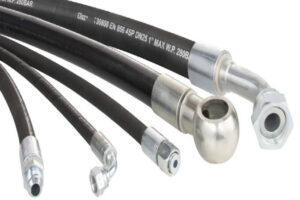
Hydraulic hoses are synthetic rubber tubes attached to hydraulic systems to enable the smooth movement of fluid between two components while also protecting them from outside contaminants. Features mainly include valves, tools, and actuators. These hoses are an essential part of almost all hydraulic systems. It acts as a link to ensure the transmission of energy in the hydraulic system. It typically consists of three parts: an inner tube that carries the fluid, a reinforcement layer, and a protective covering. Additional protective covers may be added to the lines to protect them from extreme heat or abrasion.
Hydraulic hoses are of different types, and their configurations depend on the end-use. However, the five most common hydraulic hoses are:
- SAE standard hose.
- Standard high-pressure hose.
- Steel wire braided hose.
- Thermoplastic hydraulic hose.
- Low-pressure hose.
The two primary purposes of hydraulic hoses are facilitating the movement between two port locations and minimizing the vibration effects. Three main kinds of liquid generally pass through a hydraulic hose: petroleum oil, synthetic oil, and liquid with high-water content. The fluid is transmitted at extremely high pressures and speeds.
When choosing a hydraulic hose for an application, you need to consider various essential factors. The hydraulic hose must be of the right quality to prevent machine failures, resulting in expensive damage and leading to a mess that could have environmental ramifications.
Size
It would help determine the inside diameter (ID), outside diameter (OD), and hose length. The inside diameter should have the capacity to accommodate hydraulic fluid while simultaneously minimizing the pressure loss to counter the vibrations.
Temperature
The hydraulic hose materials have a specific operating temperature range. It should be aligned to the minimum and maximum temperature of the system. It would help if you considered both the ambient temperature and the media temperature.
Application
It would be best if you determined the end-use of the hydraulic hose. You should check for essential factors like environmental conditions, fluid compatibility, working and spike pressures, routing requirements, and other factors.
Material
Determine the nature of the material which is to be conveyed through the hose. Check the compatibility chart to ascertain if you use the hose to transfer the concerned material.
Pressure
The hydraulic hoses are rated for maximum system pressure. You should have the details about the system pressure and the pressure spikes.
Ends/Couplings
It refers to the ends of a hose designed for connection. It should be appropriately matched to their components so that there is no leakage. Identify the thread type the system uses, and then select suitable ends compatible with these thread types.
Delivery
You should determine the fluid volume that will pass through the hose. It will help you choose the right type of hose that can remain durable for a more extended period.
To Conclude:
To track all of these factors, you can refer to it as the STAMPED framework. It will help you to choose the proper hydraulic hose for your applications.


Leave a Reply